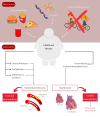A Systematic Review of the Long-Term Trajectory of Hemodynamics and Body Composition in Childhood Obesity
- PMID: 34912641
- PMCID: PMC8664398
- DOI: 10.7759/cureus.19504
A Systematic Review of the Long-Term Trajectory of Hemodynamics and Body Composition in Childhood Obesity
Abstract
Obesity has long been cited as a significant risk factor for high blood pressure, with long-term exposure linked with an increased incidence of carotid artery atherosclerosis. However, as obesity is becoming more common in young-aged children, it is important to recognize combinational factors like lifestyle, socioeconomic, and genetic factors as a cause. Increasing weight during childhood, on the other hand, is a clinically significant challenge for many physicians. It is critical to identify these risk factors since early prevention (primordial prevention) or treatment (primary prevention) to reverse the potential risks is much more likely to be effective. The objective of this review was to explore the relationship between lifestyle, anthropometric, and genetic factors and cardiometabolic risk factors. We are hopeful that our findings may aid in the primary prevention of hypertension in children and the prevention of any related cardiovascular complications that may arise later in life as a result of obesity. The synthesis of this systematic review includes a total of 15 studies using defined criteria, published up to October 2021. In addition, a total of 2,397 articles were found through an initial electronic database search and included a total of 38,182 participants. Studies explored included one or more of the following cardiovascular risk factors: body mass index (BMI), systolic blood pressure (SBP), diastolic blood pressure (DBP), high-density lipoprotein (HDL) cholesterol, low-density lipoprotein (LDL) cholesterol, and triglycerides (TG). The findings of this study support the notion that childhood obesity may be a risk factor for a variety of adult cardiovascular disease risk factors. Several behavioral, genetic, and anthropometric factors are linked to the development of obesity during early ages, overall creating challenges in cardiovascular health during adulthood. As a result, addressing the risk factors for childhood hypertension would be advantageous for the primary prevention of its sequelae in adulthood.
Keywords: body mass index: bmi; cardiovascular risks; childhood obesity; diastolic blood pressure; hemodynamics; hypertension in young patients; obesity adolescent anthropometry.
Copyright © 2021, Suri et al.
Conflict of interest statement
The authors have declared that no competing interests exist.
Figures
References
-
- Heart disease and stroke statistics—2016 update: a report from the American Heart Association. Mozaffarian D, Benjamin EJ, Go AS, et al. Circulation. 2016;133:0–360. - PubMed
-
- Obesity-related hypertension: possible pathophysiological mechanisms. Vaněčková I, Maletínská L, Behuliak M, Nagelová V, Zicha J, Kuneš J. J Endocrinol. 2014;223:0–78. - PubMed
-
- Childhood adiposity, adult adiposity, and cardiovascular risk factors. Juonala M, Magnussen CG, Berenson GS, et al. N Engl J Med. 2011;365:1876–1885. - PubMed
Publication types
LinkOut - more resources
Full Text Sources
Research Materials
Miscellaneous


